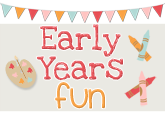Here's a fun little game that I like to play with my class as a 'warm up' for our Maths lesson.. its a great one to practice writing and sequencing numbers, with a good dose of strategy thrown in too!
We call it.... BLAST OFF!
To play, you just need to draw a rocket on your whiteboard, with some windows on it. The number of windows will determine the complexity of the game, for my little Receptions, I normally use 5 or 6. The aim of the game is to fill all the windows with numbers in sequence before getting three strikes (though if we haven't 'won' the game for a while, I give us some extra strikes to make it easier!) Someone then rolls a 1-10 die, and calls out the number and the class decides on a window to write the number in.
We have some really great conversations about number order, relative position in a number line, chance and strategy... I find the kids really get into it! If you roll a number, but can't make a move, a strike is recorded (by crossing out a star) - three strikes and you're out.
You could easily differentiate it for older kids by having more windows on the rocket, using two/three dice and making 2/3 digit numbers from the numbers rolled, or adding the numbers together, doubling the number... the list goes on :)
It's a fun, easy game to play, and I find kids really enjoy it... great for strategic thinking too!




































